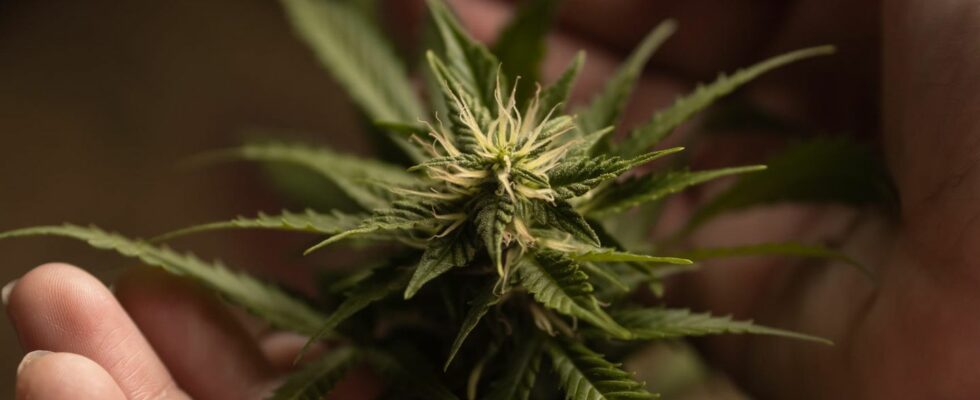Cannabis for menopause
Can marijuana make transitioning easier for women?
© Iryna Yablonska / Adobe Stock
Grass is being hyped as a new remedy for typical menopausal symptoms. You can find out here what cannabis can do in this regard and what the studies are on it.
Two studies have caused a stir in North America. In both, women provided information about the extent to which they treat their menopausal symptoms through cannabis use – in the course of Cannabis legalization in Germany is an interesting approach. What can really be expected from this?
What is cannabis supposed to help with during menopause?
Almost 80 percent of those within one Opinion poll Perimenopausal and postmenopausal women surveyed at Harvard University in Boston, USA, said they consumed cannabis for their menopausal symptoms. A Canadian one survey Although the figure in Alberta/Canada was significantly lower at 34 percent, 75 percent of these women, with an average age of 49, used cannabis to cope with their menopausal symptoms.
The reasons given also show clear parallels. The most common benefit was given by women sleep disorders (67.6 percent for the data from the USA and 65 percent for those from Canada), followed by anxiety states (46.1 percent and 45 percent, respectively). Also Muscle/joint pain was an issue among Canadian women at 33 percent, while libido was an issue among American women at 30.4 percent. However, vasomotor complaints such as hot flashes or night sweats, which are considered to be the most common symptoms of menopause, were not among the areas of application.
Reading tip: Here you will find detailed information about sleep disorders during menopause, joint pain during menopause, hot flashes during menopause.
Important: The choice of words “survey” and “survey” is already a clear indication that it is Self-disclosure and application observations and not reliable, scientific studies on effectiveness – there are simply no such studies on this topic, even though 100 percent of women will, are or were affected by menopause (in this context, also read our article about the gender health gap). But the results still prove one fact: Women are already using (medical) cannabis to help them get through menopause better and to alleviate their individual complaints.
For women who do not want hormone replacement therapy or who are not allowed to receive it for medical reasons (e.g. because of cancer), Cannabis consumption could possibly be an alternative. Discuss your options with your gynecologist.
How is the soothing effect explained?
The assumption that cannabidiol can be effective against menopausal symptoms Many experts consider this to be fundamentally plausible. Because the human body has one Endocannabinoid system (endogenous = coming from within) with corresponding receptors to which the cannabinoids can dock. It is part of our nervous system. The body’s own molecules are called endocannabinoids, including anandamide.
The endocannabinoid system is closely linked to estrogen balance. This anandamide is produced in the ovaries, the place where estrogen production also takes place, and its highest concentration is measured around ovulation. After menopause, the last menstrual period, the estrogen level drops sharply until production almost comes to a standstill. Even if the effects have not yet been the subject of scientific analysis, a connection is obvious.
With or without high: The difference between THC and CBD
Cannabis is the Latin name for the hemp plant (Cannabis sativa), one of humanity’s oldest cultivated and medicinal plants. It was probably used as an intoxicant or medicine as early as 4,000 years ago.
The plant is characterized by two special features: It is dioecious, which means there are male and female plants. And only the female cannabis plants produce the active ingredients for which they are known: cannabinoids. Around 120 of these cannabidoids, which dock onto special receptors in the body, have been identified so far. The two most important:
- THC (Tetrahydrocannabinol) – psychoactive (with intoxicating effects), can have a mood-enhancing effect and reduce the urge to vomit
- CBD (Cannabidiol) – non-psychoactive (does not cause a high), has an anti-anxiety and anti-inflammatory effect
With the partial legalization of cannabis in Germany, adults can possess 50 grams and up to three female plants at home and carry 25 grams with them on the go.
What’s what?
| cannabis | Hemp plant (Cannabis sativa) |
| marijuana | Dried flowers of the female hemp plant (also grass, weed, pot) |
| hashish | Extracted resin from female hemp flowers (also hash) |
Whether you smoke the “substance”, bake it in cookies or consume CBD products is up to you. Every person is different and not everyone reacts equally to the active ingredients. If you’re interested, it’s best to try out what you get along with best. The clear advice from medical professionals: The negative effects of inhaling exceed the presumed benefits of cannabis, which speaks against smoking.
Medical cannabis has been prescribed by a doctor in Germany since 2017, especially for chronic pain disorders, multiple sclerosis, spasticity and cancer. There is currently no evidence of effectiveness for menopausal symptoms (although there is no evidence disproving their effectiveness), so the products for this purpose are currently not available on prescription.
CBD is available for sale freely and is usually offered in the form of capsules, drops (food supplement) or oil (internal and external use).
Sources:
- Babyn K, Ross S, Makowsky M, Kiang T, Yuksel N. Cannabis use for menopause in women aged 35 and over: a cross-sectional survey on usage patterns and perceptions in Alberta, Canada. BMJ Open. 2023 June 21
- Federal Ministry of Health: Questions and answers about the “Cannabis as Medicine” lawas of November 17, 2022
- Dahlgren, M. Kathryn; El Abboud, Celine; Lambros, Ashley M.; Sagar, Kelly A.; Smith, Rosemary T.; Gruber, Staci A.: A survey of medical cannabis use during perimenopause and postmenopause. Menopause 29(9) 1028-1036, September 2022
- Dingermann T. Basics of the pharmacology of cannabinoids. Pain medication 2021;37(Suppl 1):8–13

